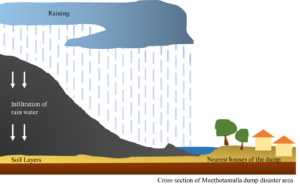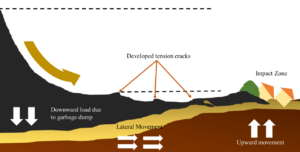Landslides are not a novel experience to Sri Lankans who still bare the dark memories of recent disasters namely; Koslanda/Meeriyabedda in 2014, Kotmale in Nuwara Eliya in 2015 and Aranayake in Kegalle in 2016.
However the catastrophic slope failure occurred at the municipal solid waste disposal site at Pothuwilkumbura, Meethotamulla, Kolonnawa on April 14th 2017 was the first of its kind in Sri Lanka that made us to reconsider ‘human-garbage’ conflict. Like a monster in prey, the huge mount of garbage collapsed when the whole country was in a festive mood of Sinhala Hindu New Year, and the families gathered in their homes to celebrate. 1059 people from 246 families were affected and 32 deaths, 11 injuries and 8 missing had been reported. 80 houses were fully damaged where 17 were partially. The most empathetic face of this incident was these people who affected, not dwelled near the waste mount but the waste mount was built near them.
“This is where our ancestral homes were. We moved here in 1980. We did not come and settle near a garbage dump. The dump gradually grew and it found us.”
(Mr. Keerthirathna Perera, Convener, People’s Movement Against Meetotamulla Garbage Mound, Nation 4th Jan 2016)
Also they were not buried by a natural mount of soil but in the manmade garbage.
“Garbage landslides are particularly horrible events. For most people being buried alive raises an inbuilt fear, but the thought of being buried by garbage is particularly unpleasant. In addition, garbage often releases toxic gas, which means that victims may die from poisoning whilst awaiting rescue. Garbage also generates heat, which means that the victims may be die from hyperthermia. In extreme cases the garbage may ignite.” (Petley, 2010)
Most of developing countries use uncategorized, open landfills as a primary solution for municipal solid waste due to lack of infrastructure, lack of resources and especially absence of proper waste disposal provisions. This has been caused for many environmental, health, social and political issues. When considering the incidents occurred in past two decades (Table 01), garbage dump landslides are a significant problem for countries in the developing world
Table 1: Large scale (death toll over 10) garbage dump landslide incidents occurred during past two decades (Source: Pappas, 2017)
Date Location Country Death toll
10th July 2000 Manila Philippines 287
14th June 2002 Chongqing China 10
21st Feb 2005 Cimahi, Bandung Indonesia 143
01st Sep 2005 Padang, Sumatra Indonesia 25
07th Oct 2005 Shang Luo City China 13
07th Oct 2005 Bello, Medellin Colombia 43
20th June 2008 Guatemala City Guatemala 50
17th March 2017 Addis Ababa, Ethiopia 115
In the context of Meethotamulla, before 1990, this location had been a low-lying, marshy ground and waste dumping at the site started in 1991 in order to infill the wetland so that make way for a housing complex. With the urban growth and rapid development, the location has been receiving waste in increasing amounts in subsequent years. In the beginning, the site had received waste only from the Kolonnawa area. Legalized waste dumping at Meethotamulla started in 2009 under the direction of the Urban Development Authority (UDA) after the closure of the Bloemendhal dump site and then the waste of Colombo Municipal Council area was also dumped at the site.
“In 2009, residents of Colombo filed a Fundamental Rights case in the Supreme Court (case number 218/2009 SCFR), alleging that Burns Trading, the private company contracted by the Colombo Municipal Council (CMC), was not properly regulating the garbage dump at Bloemendhal, Colombo 13. The court determined that further garbage dumping at the site would cease. As a temporary solution, then Chief Justice Sarath N. De Silva issued an interim order for the dumping to be redirected to Meethotamulla, Kolonnawa. Eight years since, that interim order remains the only legal authority for the Meethotamulla garbage mountain.”
(Roar report, 29th April 2017)
“The dumping was never procedurally legitimate. There was never any environmental impact assessment carried out, they did not evaluate the waterways that were contaminated. They did not evaluate the suitability of the soil… They just use the interim order of the 2009 case as an excuse for their convenience.” (Nuwan Bopage, an Attorney at Law, the Organiser of the People’s Movement against the Meethotamulla Kolonnawa Garbage Dump (PMMKGD) Roar report, 29th April 2017)
At the time of disaster, approximately 800-900 tons of waste were being dumped at the site daily as an unregulated open fill (area of 78000 m2 and the crest height about 45- 50m) where waste of all forms is dumped.
“This waste appear poorly compacted with no or thin cover soil while waste material is dumped on bare soft soils without any bottom liner. Also, no leachate or a gas collection system are installed. Only a shallow canal is present around the waste fill to collect the leachate which is generated in combination of rainfall infiltration and as a by-product from decomposition of waste.” (NBRO report, 2017)
With this legalization, residence around Meethotamulla, started several protests against dumping waste there, but nothing had happen until it collapsed. Also some issues of dumping garbage that comes from out of the Colombo municipal areas and corruption were reported.
We don’t mind if the garbage is left to decay. We just don’t want the dump to be expanded. But the government doesn’t include us in any of the discussions.”
(Mr. Keerthirathna Perera, Convener, People’s Movement Against Meetotamulla Garbage Mound, Nation 4th Jan 2016)
“Most of the waste that winds up at Meethotamulla originates outside Colombo”
(Ravindra Kariyawasam, environmentalist, Nation 4th Jan 2016)
“The Colombo municipal council has failed to find a solution to the Colombo garbage problem for 20 years, which implicates corruption.”
(Ravindra Kariyawasam, environmentalist, Nation 4th Jan 2016)
After the collapse of the dump, several suggestions had been emerged to explain the reason for the collapse. Some suggested it was result of methane explosion. However that was rejected by the National Building Research Organization (NBRO), after conducting a comprehensive study at the Meethotamulla site.
According to the NBRO report, the waste fill had been in a marginally stable condition prior to the rain spell. The additional increase of weight caused by the infiltration of the rainwater could have caused the instability in underneath soft soil resulting failure in the waste fill (Figure 01). Increase in water table and the decrease in shear strength in upper layer of the waste fill due to excessive moisture could have been the other contributory factors for the failure. As a consequence, a lateral movement of the peat layer in the direction of houses and a significant ground upheaving has taken place at the toe region. The houses/other built structures in the toe region were severely damaged (Figure 1). Further, the movements in the toe area had blocked the drainage canal passing through causing minor flood situation in the Eastern side.

Figure 1: Effect of rain to initiate the collapse (Source: Remade from the Sunday Observer 27 Aug 2017)

Figure 2: Soil layer movement and slope failure of the dump (Source: Remade from the Sunday Observer 27 Aug 2017)
Although the death of large number of persons was a tragedy, the event was an eye-opener of everyone who neglected the problem for decades. Government closed the dumping waste at Meethotamulla, soon after the incident, but still there is no any sustainable solutions except dumping to another sites. Protests were mushrooming in various parts of the country against haphazard garbage disposal immediately after the Meethotamulla tragedy and the slogan “Kolamba Kunu Apita Epa” (We don’t want Colombo’s garbage) that used by protesters made things worse. Many observers say that those protests contributed to the mismanagement of waste. However, much of this garbage is literally brought into the city by those who come there to work and it is wrong to refer to them as Colombo’s garbage. Nearly a million people are believed to come to the city daily while there are only 650,000 permanent residents there.
“We don’t have much space in our country. All of us have a responsibility in terms of waste. We must spread awareness among the people before a waste management project is started. Otherwise, a tragedy spreads panic among the people and it is not fair by them. Therefore, people must be addressed by sociologists and other responsible sections first. That is our shortcoming,” (Mr. Ilangasinghe, Director General of the WPSMSC; Ceylon Today, 30th April 2017)
Despite the damage, it is never too late to learn and it is time for all to stop blaming each other and to come to some compromise and to implement a sustainable modern system of disposing garbage. Integration of all authorities and public towards a well-planned, sustainable solid waste management strategy is needed and the lessons learnt from the Meethotamulla may important in that task.
An attitudinal change of all citizens is imperative to achieve that goal where the country is in the movement towards a blue green era.
Sources
NBRO. (2017). GEOTECHNICAL ASSESSMENT ON THE FAILURE AT MEETHOTAMULLA WASTE FILL. Retrieved from http://www.nbro.gov.lk/images/2016_pdf/Final-Report-of-Meethotamulla-to-Megapolis-PDF.pdf
Pappas, Stephanie. “Koshe Disaster: What Causes Garbage Landslides?” LiveScience, Purch, 17 Mar. 2017, www.livescience.com/58307-what-caused-ethiopia-garbage-landslide.html.
Petley, Dave. “Landslides Mudslides.” The Landslide Blog, 21 Oct. 2010, blogs.agu.org/landslideblog/2008/06/22/garbage-dump-landslides/.
https://roar.media/english/reports/reports/the-science-behind-the-meethotamulla-disaster/
http://nation.lk/online/2017/04/22/meethotamulla-a-lesson-learnt-too-late.html
http://nation.lk/online/2016/01/04/garbage-found-us.html
http://www.ceylontoday.lk/print20170401CT20170630.php?id=20083
http://www.sundayobserver.lk/2017/04/23/trash-mountain-vs-humans-%E2%80%98survival-fittest%E2%80%99
